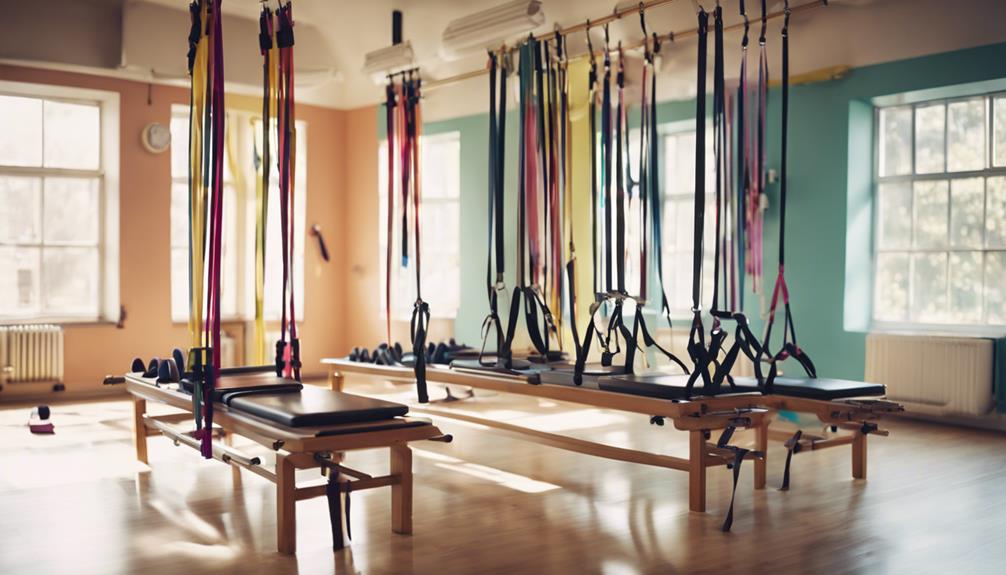Finding reliable resources is crucial when adopting a gluten-free lifestyle. I have discovered 14 essential books that cover a range of topics from practical cooking guides to educational information on the health effects of gluten. Titles like “Living Gluten-Free for Dummies” and “The Everything Gluten-Free & Dairy-Free Cookbook” offer simple recipes and assistance with meal planning. “Sweet Cravings” provides desserts specifically designed for gluten-free diets, while “The Gluten-Free Bread Machine Cookbook” makes homemade bread easier. These books not only improve cooking skills but also assist in navigating this dietary transition. Exploring these options can greatly enhance your gluten-free lifestyle. More information is available for you to discover.
Key Takeaways
- Explore a variety of gluten-free cookbooks that cater to different skill levels, from beginners to experienced cooks.
- Look for books that provide clear instructions and practical recipes for all meal types, including desserts.
- Prioritize cookbooks that offer educational content on gluten and its health effects, enhancing your understanding of dietary restrictions.
- Consider personal anecdotes and emotional support included in cookbooks to ease the transition to a gluten-free lifestyle.
101 Best Gluten-Free Foods

For anyone managing a gluten-free diet, especially those newly diagnosed with celiac disease, the 'Gluten-Free Lifestyle Books' offer an extensive guide to the best gluten-free foods that aren't only nutritious but also delicious.
These books highlight an array of gluten-free options, perfect for individuals with gluten intolerance and those looking for healthy eating alternatives.
I've found that the recipes are straightforward, making them accessible even for non-chefs. They also include tips on converting traditional recipes to gluten-free versions, which I appreciate.
Many readers have praised the variety and taste of the recipes, from cookies to various flours.
This resource is invaluable for anyone needing reliable gluten-free options while ensuring they maintain a balanced diet.
Best For: Individuals newly diagnosed with celiac disease, those with gluten intolerance, and anyone seeking healthy gluten-free options.
Pros:
- Easy-to-follow recipes make it accessible for non-chefs.
- Includes conversion tips for traditional recipes to gluten-free versions.
Cons:
- Mixed user reviews with some finding it lacking in unique content.
- Some prefer free online resources over the book's content.
The Everything Gluten-Free & Dairy-Free Cookbook

Anyone maneuvering gluten and dairy intolerances will find 'The Everything Gluten-Free & Dairy-Free Cookbook' an invaluable resource filled with easy and delicious recipes.
This cookbook addresses the common struggles many of us face when adapting to these dietary restrictions. The variety of recipes, including favorites like blueberry muffins and Southwestern tamale pie, makes meal planning straightforward.
Users appreciate that many ingredients are often already in their kitchens, simplifying grocery shopping.
While some readers find the organization of the recipes less than ideal, the overall quality remains high.
Many have recommended this cookbook to friends and family, recognizing its potential to enhance the gluten and dairy-free dining experience, making it a worthwhile addition to any kitchen.
Best For: Those navigating gluten and dairy intolerances looking for easy and delicious recipes to enhance their meal planning.
Pros:
- Easy and delicious recipes that cater to gluten and dairy restrictions.
- A wide variety of recipes, including popular dishes like blueberry muffins and Southwestern tamale pie.
Cons:
- Some users find the organization of the recipes challenging.
- Certain recipes may feel like traditional dishes with ingredients simply swapped out for alternatives.
Living Gluten-Free for Dummies, 2nd Edition

Living Gluten-Free for Dummies, 2nd Edition is an essential guide for those newly diagnosed with gluten intolerance, offering practical advice and emotional support to navigate the challenges of a gluten-free lifestyle.
This thorough resource covers everything from diagnosis to identifying gluten-containing ingredients and modifying favorite recipes. I found the author's engaging writing style made the material easy to digest, which is a real plus for anyone feeling overwhelmed.
The book also addresses the emotional aspects of living gluten-free. It offers coping strategies for dealing with negative feelings related to the diagnosis.
While it provides practical tips on reading labels and safe food selection, I noticed some readers desired clearer guidelines for kitchen cleaning and naturally gluten-free meal ideas.
Despite its US focus, it remains a valuable starting point for anyone's gluten-free journey.
Best For: Individuals newly diagnosed with gluten intolerance seeking practical advice and emotional support for a gluten-free lifestyle.
Pros:
- Comprehensive resource covering diagnosis, ingredient identification, and recipe modification.
- Engaging writing style that makes the material enjoyable and easy to understand.
Cons:
- Some readers desire clearer guidelines for kitchen cleaning and safe food selection.
- The book may have a US-centric focus, potentially limiting its applicability for international audiences.
Gluten-Free All-in-One For Dummies

The 'Gluten-Free All-in-One For Dummies' book is perfect for those newly diagnosed with celiac disease or gluten sensitivity, as it simplifies the shift to a gluten-free lifestyle with essential tips and easy recipes.
This all-encompassing guide combines multiple previous Dummies books, which makes it a one-stop resource for beginners.
I appreciate the clear food lists that distinguish acceptable from non-acceptable items, especially when eating out.
The range of recipes is practical, though I found some instructions a bit vague.
Readers generally find the book informative and user-friendly, which aids in maneuvering a gluten-free diet.
It's readily available and comes highly recommended for anyone wanting to understand and implement gluten-free living effectively.
Best For: Individuals newly diagnosed with celiac disease or gluten sensitivity looking for a comprehensive guide to adopting a gluten-free lifestyle.
Pros:
- Provides clear lists of acceptable and non-acceptable foods for easier dietary navigation.
- Offers a variety of easy-to-follow recipes suitable for beginners.
Cons:
- Some recipe instructions may be vague, leading to confusion.
- Certain recipes lack specificity regarding ingredient combinations.
Sweet Cravings: 50 Seductive Desserts for a Gluten-Free Lifestyle

For those craving indulgent desserts without gluten, *Sweet Cravings: 50 Seductive Desserts for a Gluten-Free Lifestyle* offers a delightful array of recipes crafted specifically for your needs.
This hard-bound cookbook features 50 creative gluten-free recipes, complete with beautiful photography for over half of them. I appreciate the easy-to-read font and detailed instructions, making it accessible for all skill levels.
The book is organized into six chapters, covering muffins, cookies, tarts, and more. Each recipe utilizes unique gluten-free flour blends, ensuring you can enjoy a variety of treats without compromising taste.
Priced at $11.39 on Amazon, this cookbook not only satisfies sweet cravings but also provides insights into gluten-free baking techniques and tips from the author, Kyra.
Best For: Those seeking delicious gluten-free desserts that are easy to prepare and perfect for all skill levels.
Pros:
- Comprehensive variety: Offers 50 creative recipes across multiple dessert categories.
- Accessible instructions: Features easy-to-read directions suitable for both novice and experienced bakers.
Cons:
- Limited to gluten-free: Recipes are exclusively gluten-free, which may not appeal to those without dietary restrictions.
- Potential ingredient availability: Some unique gluten-free flour blends may be harder to find in local stores.
Gluten Is My Bitch: Rants, Recipes, and Ridiculousness for the Gluten-Free

Looking for a relatable and humorous guide to maneuver life with celiac disease? 'Gluten Is My Bitch' offers a unique blend of rants, recipes, and practical advice.
This book provides essential insights for those newly diagnosed, covering everything from gluten-free shopping tips to restaurant recommendations. The author's lighthearted approach makes difficult topics more approachable, which resonates with readers facing similar challenges.
Included are easy-to-follow recipes that simplify the shift to gluten-free cooking, ensuring meals remain enjoyable and tasty.
However, it's vital to remain vigilant. Some readers caution against blindly trusting gluten-free labels, as cross-contamination can occur.
Overall, this book serves as a valuable resource for individuals and their loved ones maneuvering gluten intolerance.
Best For: Individuals newly diagnosed with celiac disease and their friends and family looking for a humorous and relatable guide to gluten-free living.
Pros:
- Offers informative insights and practical tips for navigating gluten intolerance.
- Provides easy-to-follow and tasty gluten-free recipes that make cooking enjoyable.
Cons:
- Some readers caution against assuming all gluten-free labeled products are safe due to potential cross-contamination.
- May not provide in-depth scientific explanations for those seeking a more technical understanding of celiac disease.
Gluten-Free Diet for Beginners: Create Your Gluten-Free Lifestyle

Individuals new to gluten-free eating will find 'Gluten-Free Diet for Beginners' an invaluable resource, offering practical guidance and delicious recipes tailored to their needs.
This book provides a clear overview of gluten, explaining its effects on health and the benefits of a gluten-free diet, particularly for those with celiac disease.
With over 30 recipes, it covers meals from breakfast to dessert, although some readers wish for more dinner options.
The writing is accessible, making it easy to understand gluten-free concepts.
While some critiques mention a lack of depth and visual appeal, the author's personal experiences add authenticity.
Overall, it's a useful starting point for anyone looking to embrace a gluten-free lifestyle.
Best For: Individuals new to gluten-free eating, particularly those with celiac disease or gluten sensitivity, seeking practical guidance and easy recipes.
Pros:
- Provides a comprehensive overview of gluten and its health effects.
- Includes over 30 easy-to-follow gluten-free recipes for various meals.
Cons:
- Some readers found the book lacking in depth and visual appeal.
- Limited dinner recipe options may leave some wanting more variety.
Eat Happy: Gluten Free, Grain Free, Low Carb Recipes

Whether you're a beginner or an experienced cook, 'Eat Happy: Gluten Free, Grain Free, Low Carb Recipes' offers a delightful array of flavorful dishes that elevate everyday meals.
This book covers all meal types, from breakfast to dessert, ensuring variety with unique combinations like raw Brussels sprouts in salads and fried green tomatoes.
The recipes are easy to prepare, making them suitable for anyone. They emphasize fresh, whole foods that promote health and accommodate various dietary needs.
I appreciate the user-friendly format, with visually appealing images and straightforward instructions.
Additionally, the author provides online support, which encourages culinary experimentation.
Overall, this book is highly recommended for those looking to enhance their gluten-free cooking experience.
Best For: Those seeking flavorful, gluten-free, grain-free, and low-carb recipes that cater to various dietary needs and skill levels.
Pros:
- Recipes are simple and quick, suitable for both beginners and experienced cooks.
- A diverse range of meal options is provided, including unique and creative dish combinations.
Cons:
- Some users have reported concerns about the physical quality of the book, such as pages falling out.
- The variety of options may overwhelm those looking for a more streamlined recipe selection.
Danielle Walker's Eat What You Love Cookbook

Danielle Walker's *Eat What You Love* cookbook is a game-changer for families traversing dietary restrictions and health challenges, offering delicious recipes that everyone can enjoy together.
I've noticed how this cookbook has positively impacted many families, particularly those dealing with health issues. Reviewers share transformative experiences, like one mother whose son became symptom-free from ulcerative colitis after using Walker's recipes.
The book features easy-to-follow recipes that cater to various dietary needs, making it accessible for busy families. Many have praised the flavors, noting that even those who typically prefer traditional foods enjoy the meals.
Its well-organized design and beautiful presentation make it a practical and appealing addition to any kitchen, encouraging community sharing of healthy recipes.
Best For: Families dealing with dietary restrictions or health challenges looking for delicious, accessible recipes that everyone can enjoy together.
Pros:
- Easy-to-follow recipes that cater to various dietary needs, making healthy cooking accessible for busy families.
- Delicious meals that appeal to both those with dietary restrictions and traditional food lovers, ensuring satisfaction for all.
Cons:
- Some readers may find certain ingredients less accessible depending on their location.
- The cookbook may not cater to specific dietary preferences outside of the paleo or SCD approaches.
Cook Once, Eat All Week: Gluten-Free Meal Prep

For busy families seeking delicious and nutritious gluten-free meals with minimal prep time, 'Cook Once, Eat All Week' is the perfect solution.
This cookbook features 26 weeks of meal prep recipes that utilize fresh ingredients. Each week includes three dinner recipes serving 4 to 6 people.
I found the prep day straightforward, especially when using a pressure cooker. Dishes like chicken and veggie casserole, street tacos, and salads came together quickly, making my family happy.
The recipes are budget-friendly, reducing food waste by using similar ingredients throughout the week. Plus, they're flexible enough to accommodate dietary preferences.
Overall, this guide simplifies meal planning while ensuring families enjoy tasty, healthy dinners without excessive effort.
Best For: Busy families looking for quick, nutritious gluten-free meals with minimal prep time.
Pros:
- Budget-friendly recipes that utilize similar ingredients, reducing food waste.
- Flexible meal options that accommodate various dietary preferences, including low-carb and vegan.
Cons:
- Some users may find measurements challenging if they are not familiar with US cooking standards.
- Limited variety in some weeks may not suit all taste preferences.
The Gluten-Free Cookbook for Slow Cookers

Anyone seeking to simplify gluten-free cooking while enjoying the convenience of slow cooking will find 'The Gluten-Free Cookbook for Slow Cookers' an invaluable resource. This cookbook is well organized, offering a variety of recipes for every meal, including soups, breakfasts, and dinners. It presents gluten-free versions of popular dishes, making it easier for those on gluten-free diets to enjoy familiar flavors.
The recipes range from adventurous Thai soups and Sweet Potato Curry to family-friendly Pot Roast and Mac and Cheese. Each recipe is designed for simplicity, typically requiring just 4-5 steps.
The book also provides helpful insights on health benefits, dietary considerations, and tips for maximizing slow cooker use, ensuring that both beginners and experienced cooks can expand their gluten-free repertoire effectively.
Best For: Individuals seeking to simplify gluten-free cooking while enjoying the convenience of slow cooking.
Pros:
- Well organized with a diverse mix of recipes for all meals, including soups, breakfasts, and dinners.
- Easy-to-follow instructions with concise ingredient lists, making it suitable for both beginners and experienced cooks.
Cons:
- Some recipes lack accompanying images, which may detract from visual appeal.
- Cautions against processed gluten-free options may limit choices for those looking for convenience.
2022 Gluten Free Buyers Guide

The 2022 Gluten Free Buyers Guide is ideal for those living with celiac disease, offering practical insights and product recommendations to enhance their gluten-free journey.
I found this guide particularly useful because it shares how others navigate their dietary restrictions. It includes product suggestions, websites, podcasts, and even books that can assist in my gluten-free lifestyle.
Many users appreciate the relatable stories and survey insights, which address common challenges.
Although the guide highlights popular gluten-free products, some readers note that it could include a wider range of trustworthy brands. Additionally, it's important to approach the recommendations cautiously, as some products may carry risks of gluten contamination.
Overall, this guide is an excellent resource for anyone looking to improve their gluten-free shopping experience.
Best For: Individuals with celiac disease seeking guidance on gluten-free food options and resources.
Pros:
- Insightful user experiences that share relatable challenges and solutions for living gluten-free.
- Wide range of recommendations for products, websites, podcasts, and books tailored for celiac individuals.
Cons:
- Limited range of products listed, potentially missing well-known and trustworthy gluten-free brands.
- Caution needed with certain recommendations due to potential gluten contamination in some products.
Gluten-Free Small Bites: Sweet and Savory Hand-Held Treats

Gluten-Free Small Bites is perfect for busy individuals and families seeking delicious hand-held treats that don't compromise on flavor or texture. Written by Nicole Hunn, this cookbook offers a range of satisfying recipes, from pierogis to crab rangoons.
I've found that her detailed instructions make it accessible for cooks of all skill levels, ensuring even novice chefs can produce great results.
Many readers appreciate the versatility of these recipes, especially at gatherings where gluten-free options are often overlooked. Hunn's commitment to replicating traditional flavors means that these dishes are often indistinguishable from their gluten-containing counterparts.
This quality has helped many families adapt to gluten-free diets while still enjoying familiar tastes, making it a valuable resource for anyone steering through this lifestyle.
Best For: Individuals and families seeking delicious gluten-free hand-held treats that replicate traditional flavors and textures.
Pros:
- Wide variety of recipes including both sweet and savory options, catering to different tastes.
- Detailed instructions make it accessible for cooks of all skill levels, ensuring successful results.
Cons:
- Some readers report minor issues with book presentation, such as damage during shipping.
- A few may find gluten-free cooking challenging initially, despite Hunn's clear guidance.
The Gluten-Free Bread Machine Cookbook

For those seeking delicious, homemade gluten-free bread without the hassle, 'The Gluten-Free Bread Machine Cookbook' offers 175 recipes specifically designed for easy preparation in a bread machine.
The cookbook includes detailed instructions and various flour blends, with options for both weighed and measured ingredients.
I've noticed some discrepancies; for example, the Simple Sandwich Bread recipe suggests 360 grams of flour blend, but I found only 2 cups were necessary when weighing.
Users report positive experiences, appreciating the convenience of a 10-minute setup.
The cookbook accommodates a range of dietary preferences, although some users noted the absence of Paleo-specific recipes.
Overall, it's well-received, with many finding success and satisfaction in their gluten-free baking endeavors.
Best For: Individuals seeking easy and delicious gluten-free bread recipes that can be made using a bread machine.
Pros:
- Wide variety of recipes: Includes 175 diverse options accommodating various dietary preferences.
- User-friendly: Quick 10-minute setup makes baking accessible for all skill levels.
Cons:
- Discrepancies in measurements: Some recipes may have inconsistencies between weighed and measured ingredients.
- Lack of pictures: The absence of visual aids may deter some users who prefer seeing finished products.
Factors to Consider When Choosing Books for a Gluten Free Lifestyle

When I choose books for a gluten-free lifestyle, I consider several important factors.
Recipe variety and quality are essential, as I want to make certain I've a range of options to keep meals interesting.
Additionally, I look for clear instructions and educational content, as well as personal experiences shared by the authors to better understand the gluten-free journey.
Recipe Variety and Quality
A diverse selection of recipes is important in any gluten-free cookbook, ensuring I can enjoy a variety of meals for every occasion. Good cookbooks should cover breakfast, lunch, dinner, and dessert, catering to different tastes and dietary needs. I prefer books that include both sweet and savory options, as this enhances my cooking repertoire.
Quality recipes often feature unique ingredient combinations, encouraging me to experiment with alternative flours and grain substitutes. When I'm baking, knowing which gluten-free flour blends work best is essential for achieving the right taste and texture. As a result, I look for cookbooks that provide detailed information on recommended blends.
Clear instructions and precise ingredient measurements are also important. I appreciate books that offer both weighed and measured options, as this accommodates various baking styles. User feedback plays a significant role in my decision-making process; positive reviews regarding recipe outcomes often indicate reliability and satisfaction.
Ultimately, a good gluten-free cookbook shouldn't only deliver delicious results but also inspire confidence in my culinary adventures. By focusing on recipe variety and quality, I can maintain a fulfilling gluten-free lifestyle without sacrificing flavor or enjoyment.
Accessibility of Instructions
Accessibility of instructions plays a considerable role in my choice of gluten-free cookbooks, as it guarantees I can confidently tackle recipes regardless of my cooking experience.
When I look for cookbooks, I prioritize those with clear, straightforward steps. This is especially important for beginners like me, who may not have a lot of culinary skills. Books that emphasize minimal specialized ingredients and common kitchen tools make the process less intimidating.
I also appreciate cookbooks that label dietary considerations, allowing me to quickly identify recipes that fit my needs, such as dairy-free or low-carb options. Detailed instructions help me navigate the unique challenges of gluten-free cooking, ensuring I replicate dishes accurately. Additionally, recipes that provide both weighed and measured options accommodate various levels of experience and precision.
When I find well-organized recipes categorized by meal type or ingredient, it simplifies my meal planning, especially for gatherings or special diets. Including notes on ingredient substitutions further enhances usability, making it easier to adapt recipes based on what I've on hand.
Educational Content Included
Educational content is essential for understanding the complexities of a gluten-free lifestyle and ensuring I make safe, informed choices. When selecting books, I prioritize those that explain gluten and its health effects, especially for individuals with celiac disease or gluten intolerance. This foundational knowledge is significant for steering through dietary changes.
It's also important to find resources that teach me how to read labels and identify gluten-containing ingredients. This skill is critical for making safe food choices. I appreciate books that provide emotional support sections and coping strategies, as adjusting to a gluten-free lifestyle can be challenging.
Moreover, I value educational content that includes the latest medical advice and research on gluten, helping me stay current with my dietary needs. Practical guidance on adapting traditional recipes into gluten-free versions is another important aspect I look for, as it enhances everyday cooking.
Books that detail gluten-free flour blends are beneficial, as they clarify the differences between types and their impact on baking. Finally, guidance on common challenges, such as achieving the right texture in baked goods, is essential for successful gluten-free cooking.
Personal Experiences Shared
When choosing gluten-free lifestyle books, I often look for personal stories and relatable experiences that resonate with my own journey. Many readers share that personal anecdotes in cookbooks make the shift to a gluten-free lifestyle feel less isolating. I appreciate when authors include humor and emotional support, as it eases the anxiety of dietary changes.
Moreover, I find it helpful when cookbooks feature recipes that everyone in the family can enjoy, including kids. This involvement enhances our cooking experience and makes gluten-free meals more fun. I tend to gravitate toward books that reflect my personal challenges while providing practical solutions.
Clear organization and detailed instructions are also important. I value cookbooks that offer weighed and measured options for ingredients since discrepancies can affect the final product. Additionally, I enjoy recipes that can adapt to various dietary preferences, allowing for experimentation with different options.
Dietary Restrictions Addressed
As I explore gluten-free lifestyle books, I make sure they address various dietary restrictions to meet my family's needs and preferences. It's important to take into account whether the book covers gluten intolerance, celiac disease, and even lactose intolerance. This guarantees the content aligns with our specific health requirements.
I look for books that investigate gluten's effects on health, especially for those managing diabetes or other dietary concerns. Additionally, I evaluate if the recipes cater to other dietary preferences, such as dairy-free, low-carb, or vegetarian options.
It's significant for the book to discuss common sources of gluten and provide strategies for avoiding cross-contamination, especially for those with severe sensitivities. Emotional support and coping strategies are also important, particularly for individuals newly diagnosed with gluten-related disorders.
When selecting cookbooks, I prioritize those that offer various recipes for different occasions, including appetizers, main dishes, and desserts. Detailed ingredient lists and measurements are essential for reliable gluten-free baking.
Visual Appeal and Layout
Considering the visual appeal and layout of gluten-free lifestyle books can greatly enhance my cooking experience and make it easier to navigate through recipes. A visually appealing cookbook often features high-quality, full-color photographs that not only illustrate the recipes but also inspire me to try new dishes. An organized layout with clear headings and a detailed table of contents allows me to locate specific recipes or topics quickly.
I appreciate easy-to-read fonts and appropriate print sizes, as they contribute to a more enjoyable reading experience. Cookbooks that include sections on dietary considerations, cooking tips, and ingredient lists enhance usability, helping me identify recipes that meet my needs. A well-designed cookbook with a sturdy binding is practical, allowing it to lay flat while I cook.
Clarity in instructions and ingredient lists is essential; it helps me avoid confusion and guarantees accurate recipe execution. Consistent formatting across recipes, such as clear headings and step-by-step instructions, promotes coherence and usability.
Ultimately, a well-organized layout and strong visual appeal can make my cooking experience more inviting and enjoyable, leading to successful gluten-free meals.
Author's Expertise and Background
Choosing gluten-free lifestyle books requires me to pay close attention to the author's expertise and background, as their experience can greatly impact the quality and reliability of the recipes.
Authors who've personal experiences with gluten intolerance or celiac disease often provide relatable insights, which can enhance the engagement of the content. Their firsthand knowledge helps them understand the challenges readers face.
It's also important to evaluate the author's professional background. A degree in nutrition, dietetics, or culinary arts can greatly boost the credibility of the recipes and advice presented. Authors who've successfully shifted to a gluten-free lifestyle typically share practical tips, making it easier for readers to adapt.
Recognition within the gluten-free community, such as accolades from culinary competitions or published work in popular media, can further indicate the author's expertise. Collaborations with healthcare professionals guarantee that the information aligns with current medical guidelines.
Engaging authors who respond to audience inquiries create a sense of community, enhancing the learning experience. Ultimately, by focusing on the author's qualifications, I can select books that offer reliable and effective guidance for embracing a gluten-free lifestyle.
Practical Meal Planning Tips
Practical meal planning can transform the gluten-free lifestyle into a manageable and enjoyable experience. I find that planning meals on a weekly basis simplifies grocery shopping and helps maintain a balanced diet.
By batch cooking similar ingredients, I can reduce preparation time and minimize waste, using leftovers creatively throughout the week.
Incorporating a variety of gluten-free recipes is essential to keep meals interesting. This variety prevents dietary fatigue and encourages me to stick to my gluten-free regimen.
I recommend utilizing simple meal prep techniques, like assembling meals in advance or using slow cookers, especially on busy days.
Creating a pantry list of essential gluten-free staples streamlines my meal planning. It allows me to whip up quick and nutritious meals on short notice.
When choosing cookbooks, I prioritize those that offer diverse recipes tailored specifically for gluten-free diets, ensuring options for both savory and sweet dishes.
I also look for resources that provide clear instructions and accommodate various dietary preferences, like keto.
Additionally, cookbooks featuring meal plans or themed menus can greatly enhance my grocery shopping and meal preparation, making my gluten-free lifestyle easier to maintain.
Frequently Asked Questions
How Can I Identify Gluten-Free Products While Shopping?
When I shop for gluten-free products, I always read labels carefully. I look for certified gluten-free symbols and avoid items with wheat, barley, or rye. It's become a habit that keeps my meals safe and enjoyable.
What Are Common Gluten-Free Grains to Include in My Diet?
When I first switched to gluten-free, discovering quinoa felt like finding treasure in the pantry. Now, I regularly include rice, buckwheat, and millet in my meals for variety and nutrition, keeping my diet exciting and healthy.
Are Gluten-Free Diets Suitable for Everyone, Including Children?
I believe gluten-free diets can be suitable for many, including children, but it really depends on individual needs. It's crucial to consult with a healthcare provider to guarantee balanced nutrition and avoid unnecessary restrictions.
How Do I Manage Cross-Contamination in My Kitchen?
Managing cross-contamination in my kitchen means I've dedicated separate utensils and cutting boards for gluten-free foods. I also keep my pantry organized, labeling items clearly, and I always clean surfaces thoroughly before cooking.
What Are the Health Benefits of a Gluten-Free Lifestyle?
I've noticed several health benefits since going gluten-free. My digestion improved, I've got more energy, and my skin feels clearer. It's helped me become more aware of what I'm eating and how it affects me.
Are Ayurvedic Lifestyle Books Compatible with Gluten-Free Living?
Looking for the best ayurvedic lifestyle books for healthier you while living a gluten-free life? Many ayurvedic principles are naturally gluten-free, making them compatible with a gluten-free lifestyle. These books can provide valuable guidance on achieving a balanced and healthy life through Ayurveda without worrying about gluten.
Can Ayurvedic Principles Support a Gluten-Free Lifestyle for Healthy Eating?
Discover how the traditional principles of Ayurveda can help you maintain a gluten-free lifestyle for healthy eating with some of the best ayurvedic lifestyle books. Learn about natural remedies and dietary guidelines that can support your overall well-being and make your gluten-free journey more enjoyable and fulfilling.
Conclusion
In summary, embracing a gluten-free lifestyle doesn't have to be intimidating.
With the right resources, like the books listed above, you can simplify meal planning and discover delightful new recipes.
After all, isn't it better to focus on delicious options rather than what you can't eat?
By selecting the right guides, you're well on your way to enjoying a diverse and satisfying gluten-free diet that enhances your health and well-being.
Happy reading and cooking!










